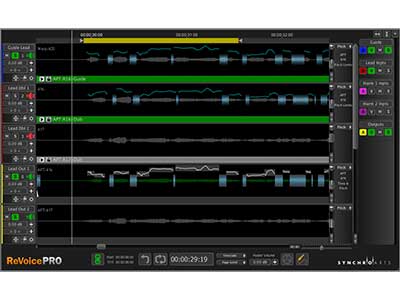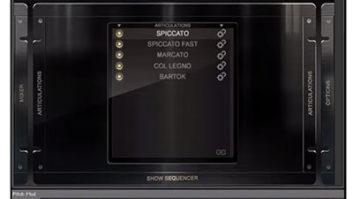
Synchro Arts is a UK-based company with software products that focus on advanced manipulation of audio. Their products include VocALign for aligning music and dialog, and Titan for conforming multichannel production audio to EDLs, synchronizing Pro Tools sessions to picture edits, and much more. Revoice Pro Version 3.1 is the company’s latest effort, and it seems to be on a rocket ship trajectory. The jump between V. 3 and V. 3.1 was quick and substantial, and there are more and newer features on tap for release soon.
The toolset in Revoice Pro is unique and impressive (see Fig. 1). It brings VocALign to the group, offering new features and a slick new algorithm that aligns to pitch traces when energy alone is flat and doesn’t do the trick. Other features include advanced tuning, an incredible doubler that creates mono or stereo doubles from a single track, and a great editor that allows you to move audio just like you would in your DAW. One of the editor’s strengths is that if there are pocket tweaks you want to perform outside of alignment, you can do it without having to go back to the DAW and re-importing.
In and Out
But before we get into the tools that make Revoice Pro unique, let’s talk about one of its best features: how it ports audio in and out from your DAW. In this case, I was using Pro Tools, but the software works with a large list of DAWs and software including Logic Pro, Cubase, Studio One, FL Studio, Nuendo, Sonar and others. While Revoice Pro is a stand-alone application, it comes with a group of plug-ins allowing it to communicate to the DAW.
It all starts with the Revoice Pro Monitor plug-in that lives on a stereo aux track in Pro Tools, allowing you to monitor what’s going on inside of Revoice Pro session. This, however, doesn’t mean you’re married to your DAW for monitoring; once you have tracks inside a Revoice Pro session, the software can work on its own. If you bounce a two-mix of your session into the software, you can have everything—your separated tracks, plus a reference to your mix, all without using your DAW. This way you can make all your changes, then Spot the files back later. This would be great for editing on a MacBook Air or some other platform where a large Pro Tools session run from an external drive would tax the system. With some simple prep and import into Revoice Pro, you could take this all on a plane with some headphones and get the files back to the session on a bigger system later.
The three remaining plug-ins are in the AudioSuite format and include Quick APT (Audio Performance Transfer), Pro Doubler and Pro Link. The Pro Link plug-in sends selected audio out to Revoice Pro for general editing and back again via Capture and Spot buttons. Pro Doubler does the same, but addresses the Doubler algorithm. The coolest is the Quick APT. Once you have a preset established inside Revoice Pro, it jets selected audio out and back again as fast as the processor can handle it. You never have to leave Pro Tools or even look at Revoice Pro; just have it open.
Alignment and More
VocALign is an impressive tool. It uses a Guide and Dub architecture born out of the post-production world. Guide would be the ideal for the performance, and the Dub is the track you wish to align to the Guide. I’ve used this many times in the past and it is impressive, but not as impressive as it now sits in Revoice Pro. There are myriad tweaks you can perform, including timing tolerance set in milliseconds, protection of transients set as a percentage, four flexibility adjustments, plus global pitch and level alignment that also has many tweaks. Up to 26 of these versions can be saved as a preset, then quickly A/B-toggled using the letter “q” as a shortcut or via a pulldown menu.
When you choose to move a slider or change an option, it is instantly updated in the Output track that carries the “fixed” version. Even if you have a solidly aligned and tuned double, for instance, you can move a piece of audio in the Guide and the Output track will change to reflect your move. If you try and change the Output track, the software reminds you that you need to make any changes to the original so everything can be updated. This feature keeps you from having multiple versions floating around. It’s brilliant.
The Doubler offers many sonic possibilities. Once you create the process, you can choose from a list of 14 presets, or let it go to default and then alter, save and compare your possibilities. Settings include Average Delay (in positive and negative numbers), Frequency and Depth of modulation, Randomness (percentage), Formant shift, Vibrato, and Range of pitch detection. If you’re creating a stereo double, you can move these parameters around per channel, creating infinite possibilities. Any tweaks you make are immediately updated to the Output track, giving it a real-time plug-in feel, with no DSP hit.
Any of the separate pitch events can be grouped and moved freely without effecting pitch or timing. The interface makes it easy to see these words, breaths included, and move them to a better pocket or to change the arrangement. Because the pitch view lays directly over the audio, as you’d view it in your DAW, it makes it a more usable editing experience that is lacking in other platforms. One thing on my wish list here is to be able to set a tempo and access a grid to which you could freely move, nudge or snap your audio.
Tune It Up
The tuning function is excellent, with a look that is more Melodyne than Auto-Tune (see Fig. 2). I use all the current tuning software, and this is on par with the best. There is a note value on the left side of the track, and you can freely move the tuning trace away from the audio—this is liberating, like having an extra vertical workspace. Each pitch is separated and can be moved or auto-corrected on a percentage basis. There is not a way to choose a key for the session; that would be a powerful addition to the feature list.

Editing within the GUI is a breeze. For example, you can freely manipulate the dynamic range of vibrato and pitch drift by clicking at the top or bottom of the pitch and moving it up or down. There are some handy shortcuts for the Selector, Cutter, Join, Smooth Join, Pencil and Correct Pitch tools for quick jumps between functions. You can also add Warp Points that will be familiar to Elastic Audio users. Carefully placing these points around a pitch event allows you to time stretch or compress your audio to taste.
To try and sum up Revoice Pro in a couple of pages is tough. I haven’t even talked about the advanced automation functions that let you globally move and randomize numerous parameters, or the handy group function. What I like most is how it accomplishes the transfer of audio in and out of Pro Tools. I also like that it is not a plug-in. When you make the changes, you can pop them back to the DAW for anyone to hear down the line, whether they have Revoice Pro or not.
During the review, I missed the ability to choose a key, individual note opt-in/out, and the ability to access a tempo grid. I brought this up to the guys at Synchro Arts, and they told me about a new version in beta that addressed those very things. It’s nice to see such a rapid pace of development and care taken with this product.
What makes a good product great, especially when it has the ability to make something sound un-musical, is the ability to be subtle in a sophisticated way. Revoice Pro offers all this and more. If you want to hear the results for yourself, listen to the audio examples I’ve posted online to audition the alignment and tuning functions. The best part is that I made the changes in the examples quickly and easily, and I’m not yet an expert user.
I try not to gush about products in a review, but there’s no way to hold myself back here. Revoice Pro is an essential tool for audio production. Try it now. It’s a one-stop alignment, tuning, doubling and editing companion tool for your DAW that saves time, sounds excellent and is rapidly improving itself. It is a solid investment for audio workflow that will take your content to the highest possible level, and you have to love that.
Kevin Becka is Mix’s technical editor.
TRY THIS
Once you have multiple processes going in a Revoice Pro session, create separate groups for all your Guide, Dub and Process tracks. This way you can quickly jump between views of groups, or easily solo or mute the groups in your session.
Product Summary
COMPANY: Synchro Arts
PRODUCT: Revoice Pro Version 3.1
WEBSITE:SynchroArts.com
PRICE: $599 new; $180 upgrade from Revoice Pro V. 1 or 2
PROS: Excellent tuning, doubling and alignment functions.
CONS: No tempo grid or key selections in the GUI.






